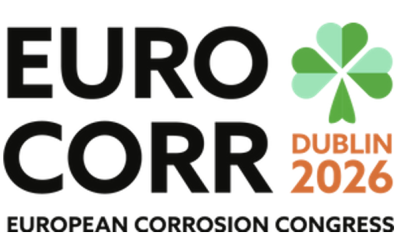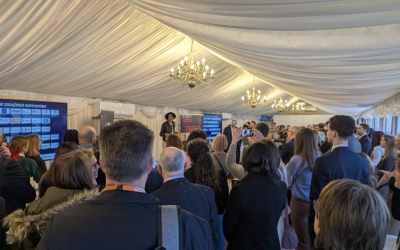On Tuesday, 28th January 2025 the Institute of Corrosion (ICorr) Aberdeen Branch held our annual joint event with Energy Institute. Dr Yifeng Zhang of Imperial College, London, gave a most interesting presentation on ‘Mon Ami – An Integrated Assessment Framework for Evaluating Inspection and Monitoring Strategies for Corrosion Surveillance.’
Yifeng Zhang is a postdoctoral research associate in the Non- Destructive Evaluation (NDE) group at Imperial College. He received his MEng degree in Aeronautical Engineering in 2018 and his PhD degree in Mechanical Engineering in 2022, both from Imperial College. In 2023, Yifeng was awarded the Institute of Physics Bob Chivers Prize for authoring the best research paper in physical acoustics. His research interests focus on the development of Structural Health Monitoring (SHM) systems and their applications in ensuring structural integrity, enhancing operational efficiency, and driving scientific innovation, particularly in the areas of chemical, electrochemical, and energy storage systems.
Synopsis: Corrosion poses a significant challenge to engineering structures, increasing the risk of service disruptions and safety incidents. Traditionally, ultrasonic Non-Destructive Evaluation (NDE) techniques for corrosion surveillance have relied on either periodic surface scans or continuous monitoring at a limited number of locations, which can prove unreliable. However, recent advancements in sensor technology and autonomous robotic systems have introduced innovative concepts, such as resident robots for asset inspection. These developments now enable the deployment of fleets of reconfigurable sensors capable of collecting spatially and temporally diverse data. To ensure the effectiveness of this new approach, thorough validation and comparison with established methodologies are essential.
The studies intend to assess the efficacy of different hybrid inspection/monitoring approaches. The proposed solution is a multi-stage framework for performance evaluation with 3 critical steps:
- Model 4D defect evolution in space and time.
- Performance assessment for different inspection and monitoring approaches in various scenarios.
- Simulate NDE measurement and associated errors.
In Stage 1 the NDE Group Model Uniform Corrosion
- Uniform corrosion is described as uniform thickness loss and change in surface roughness over time.
The NDE group can also model defect growth: Three contributing factors to the stochasticity of defect growth rate are:
- Dt • Pit initiation time • Initial pit growth rate
Secondly, the NDE group model Spatial Aspect of localised defects which is the defect geometry and spatial footprint.
The measurement accuracy depends on factors such as:
- Location • Relative size • Surface roughness
A hemispherical shape is assumed, defined by pit aspect ratio (AR=diameter/depth) The defect spatial distribution is uniform (i.e. random) and the position of corrosion follows certain distributions (e.g. Concentrated frequently at 6 o’clock position of a pipe).
In matching real-life measurements, the NDE group generates a corrosion map that resembles in-field measurements at a specific point in time, and we calculate the thickness distribution and extrapolate its evolution both before and after.
In the 3rd part of the process, the NDE group aims to understand measurement error due to the applied NDE techniques. An NDE filter is configured based on findings from previous studies of the effect of surface roughness on ultrasonic thickness measurements. Finally, the NDE group assesses the error associated with data acquisition procedures and applies that to the modelling.
Regular inspection is conducted by corrosion mapping or C-scan.
For spatial coverage, a full scan gives comprehensive information on asset conditions, while a partial scan by subsampling is often required due to access and cost constraints. Regarding inspection intervals, the data acquisition is programmed for selected time instances and is a time-based, risk-based or compliance-based inspection.
Alternatively, monitoring can be performed using permanently installed sensors. Data is then acquired via a small number of sensors ‘permanently’ installed on structures (potentially at the identified hotspots) to monitor thickness loss with enhanced temporal resolution.
Ultrasonic data can be used to match trends to those of chemical and operating data to give insights into rate of corrosion and causes.
The integrated framework allows for the assessment of various mixed inspection and monitoring scenarios, highlighting the potential benefits of the proposed hybrid approach. Furthermore, the framework has been developed into a stand-alone graphical user interface (GUI), offering researchers and industry professionals a versatile tool to evaluate degradation phenomena relevant to their applications.
Please contact the Aberdeen Branch Chair ABZchair@icorr.org if you wish to present at future events, or for any further information on upcoming events and check www.icorr.org/events/
Further information about the Aberdeen Branch, and past presentations, may be found on their Website page: Aberdeen Branch – Institute of Corrosion https://www.icorr.org/aberdeen/ under Local Technical Programme and to join the Aberdeen Branch mailing list, please contact: ABZchair@icorr.org
Photo: Dr Yifeng Zhang of Imperial College Presenting.
Photo: Degradation Phenomena.
Figure 1: Uniform Corrosion Modelling.
Figure 2: Defect Growth Rate.
Photo: The Use of Permanently Installed Sensors in Critical Areas.
Fig 3: Ideal Use of Permanently Installed Sensors.
Fig 4: Procedure to Assess the Efficacy of Hybrid Monitoring Approaches
Photo: ICorr Aberdeen and Energy Institute Aberdeen, Highlands and Islands Branch Committee Members with Dr Yifeng Zhang of Imperial College, London (4th From Right).



